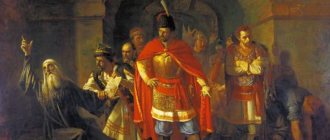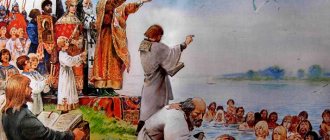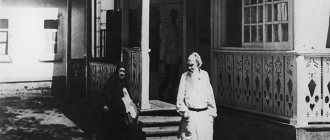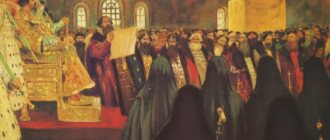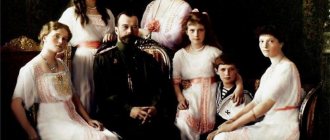Date of separation of church and state
By 1917, an education system that included religious education had become the norm for all residents of Russia. Therefore, when the decree abolished the main basis of teaching - the “Law of God”, many had ambivalent assessments of this. Already at the beginning of the 20th century, many people became atheists, but no one officially declared this. But still, the majority of Russians believed that the preservation of religious education was necessary. This mood in Russia lasted for a very long time and persisted even after the February Revolution.
Prohibitions after maternity leave
Despite the fact that the public school had already been stripped of everything spiritual, such a lesson as “The Law of God” was prohibited from being taught in any way - both in churches and even in private. Only from the age of 18, voluntarily and consciously, could one begin to study religion.
Naturally, all Orthodox Russians reacted very negatively to such changes. The Local Council received letters every day asking them to return everything to their previous places and making negative statements about the Russian government.
The fight against spiritual education
After the 2021 decree was issued, schools began to change the format of their education. But many opposed such changes, so a number of innovations followed. So, in February, a new order of the People's Commissariat for Education was issued, in which the position of law teacher was officially abolished.
That same month, a new decree was issued that prohibited the teaching of religious doctrine in public schools. It was also prohibited to conduct any rituals related to the clergy in educational institutions.
And although all the property from the church had already been taken away, in August a decree was issued which stated that it was necessary to transfer all house churches at educational institutions to the People's Commissar of property.
Development of a decree on the separation of church and state
Historians are still arguing about who initiated this document. Most researchers are inclined to believe that he was the rector of the church in Petrograd, Mikhail Galkin.
It was he who wrote and sent a letter to the Council of People's Commissars in November 1917, in which he complained about the official church and asked to be involved in active work. The letter also contained a number of measures that could allow religion to reach a new level. First of all, Mikhail asked to confiscate church values in favor of the state, as well as to deprive all clergy of benefits and any privileges.
The possibility of concluding a civil marriage instead of a religious one, as well as the introduction of the Gregorian calendar and much more, was proposed in a letter from the rector of the church in Petrograd. The Soviet authorities liked such recommendations and already in December of the same year a number of Mikhail’s measures were published in the newspaper Pravda.
How is the church separated in other countries?
Countries have varying degrees of separation between government and religious institutions. Since the 1780s, a number of countries have established explicit barriers between church and state. The degree of actual separation between government and religion or religious institutions varies greatly. In some countries the two institutions are still closely linked. New conflicts are emerging in the post-communist world.
Story
Before the overthrow of the monarchy, Russia had a state church system in which it was called the dominant one. Of course, this order was not invented in Russia; it was borrowed from Protestants by Peter the Great in 1721. According to this system, the Patriarchate was abolished, and the Holy Synod was created in its place. Such changes assumed that all three branches of government would belong to the church. And so it happened.
During his reign, Peter the Great introduced the position of Chief Prosecutor of the Synod. The emperor explained that this person should be the eyes of the sovereign and the attorney in all his affairs. This system was created in order to subordinate the church to the empire, but still place it on a level higher than the people.
Aggressive and friendly department
Scholars distinguish between what might be called "friendly" and "hostile" separations of church and state. The friendly type limits the church's interference in the affairs of the state, but also limits the government's interference in the affairs of the church. And the hostile department, on the contrary, is trying to make sure that religion does not go beyond the home or church, and is not taught anywhere.
The hostile model of secularism arose during the French Revolution and was illustrated by the Mexican Revolution, its Constitution, the First Portuguese Republic of 1910 and the Spanish Constitution of 1932. Enemy separation from the state is very similar in structure to religion associated with politics in totalitarian states.
The French secession of 1905 and the Spanish secession of 1931 have been characterized as two of the most hostile in the 20th century, although current church-state relations in both countries are considered generally friendly. However, former French President Nicolas Sarkozy at the beginning of his term considered his country's current state of affairs to be a "negative policy" and wanted to develop a "positive policy" more open to religion. Some believe that the state's concern for religion is one of the reasons for the civil war in Spain and Mexico. These are the main problems in powers where the church is not separated from the state.
The French Catholic philosopher and drafter of the Universal Declaration of Human Rights, Jacques Maritain, noted the difference between the models of France and the United States of America. He believed that the American model of the time was more amicable because it had a "sharp distinction and real cooperation" between church and state. He called this model a “historical treasure.”
Alexis de Tocqueville, another observer from France, noted that from the very beginning in the United States, religion and government were in commonwealth, and this continues to be the case today.

